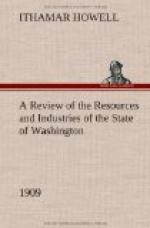[Illustration: Plate No. 3.—Chehalis County Timber.]
[Illustration: Plate No. 4.—The Logging Industry in Chehalis County.]
[Illustration: Plate No. 5.—View of Harbor, Aberdeen, Chehalis County.]
[Illustration: Plate No. 6.—Limb Cut from a Chelan County Peach Tree.]
[Illustration: Plate No. 7.—Six-Year-Old Winesap Apple Tree on Farm of Blackmont Bros., Chelan County.]
[Illustration: Plate No. 8.—Farm of Wm. Turner, Chelan County. From Sage Brush to Bearing Orchard, Showing How Living Is Made While Orchard Is Coming Into Bearing.]
FORESTS.
From British Columbia to the majestic Columbia river and from the Cascade mountains westward to the ocean a vast forest of magnificent timber stretches out over mountain and hill and valley, covering the whole landscape of western Washington in a mantle of living green. The majestic fir trees, which, as small evergreens, adorn the lawns of other climes, here stretch their ancient heads 300 feet heavenward and give the logger a chance to stand upon his springboard and, leaving a fifteen foot stump, cut off a log 100 feet in length and 7 feet in diameter free from limbs or knots. Side by side with these giants of fir are other giants of cedar, hemlock and spruce crowded in groups, sometimes all alike and sometimes promiscuously mingled, which offer to the logger often 50,000 feet of lumber from an acre of ground.
But these great forests of western Washington are not all the forests within the state. The eastern slope of the Cascade mountains well down toward the lands of the valleys is mostly covered with timber. A belt from 30 to 50 miles wide stretching clear across the north boundary of eastern Washington is mostly a forest, while a large area in the southeastern corner of the state, probably 24 miles square, is also forest covered.
To estimate the amount of timber which can be cut from these vast forest areas is difficult; estimates are not accurate, yet it is probable that the lumber made will in time far exceed any estimate yet placed upon this chief source of the wealth of the State of Washington. Of the fir the estimate has been made that shows still standing enough timber to make 120 billion feet; for the cedar the estimate is 25 billion feet, while the same amount of 25 billion feet is credited to hemlock; 12 billion feet of spruce are claimed, 12 billion feet of yellow pine and probably 6 billion feet of other woods, including maple, alder, oak, yew, ash and many others, together forming the great mass of 200 billion feet of lumber. Where forest areas are cut off, the [Page 10] sun and air at once start to life seeds which lie dormant in the shade and a new crop at once starts and the old ground is in a few years reforested in nature’s prodigal way, a thousand seeds sprouting and growing where only one giant can ultimately stand.




